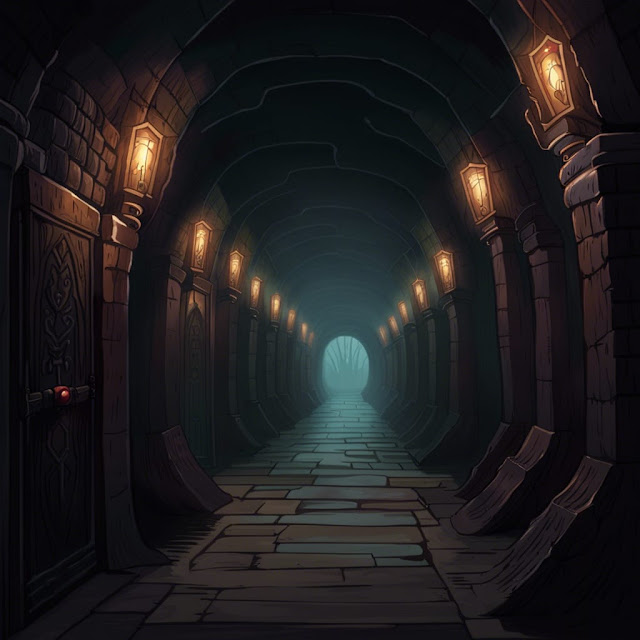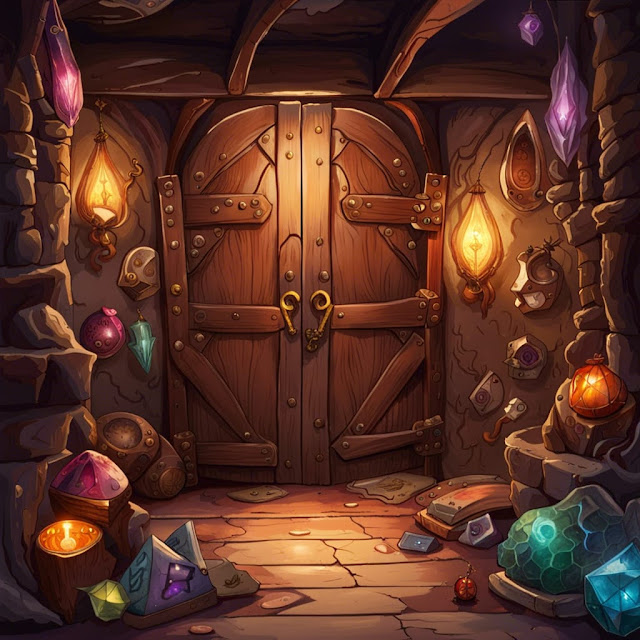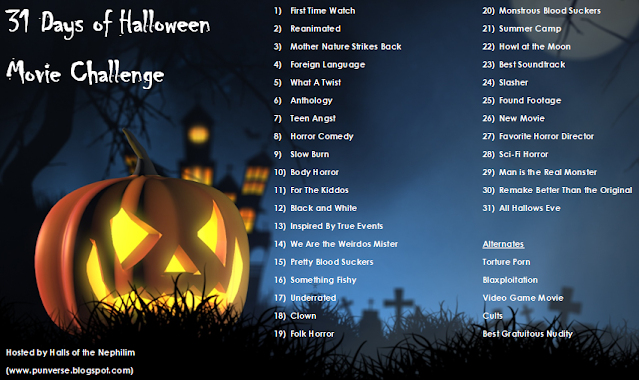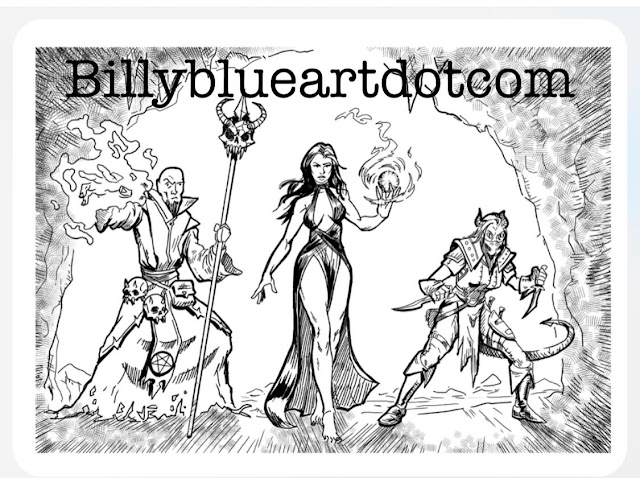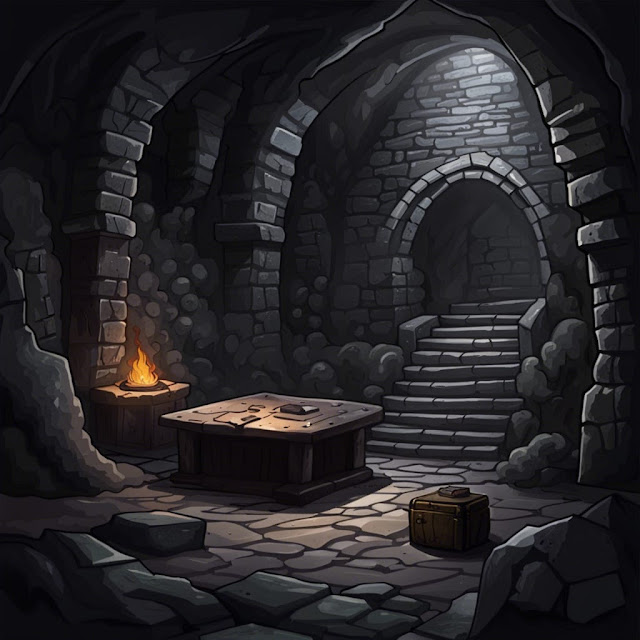Screen Shot XI
The GM Screen is a essentially a reference sheet, comprised of several card sheets that fold out and can be stood up to serve another purpose, that is, to hide the GM's notes and dice rolls. On the inside, the side facing the GM are listed all of the tables that the GM might want or need at a glance without the need to have to leaf quickly through the core rulebook. On the outside, facing the players, can be found either more tables for their benefit or representative artwork for the game itself. This is both the basic function and the basic format of the screen, neither of which has changed all that much over the years. Beyond the basic format, much has changed though.
To begin with the general format has split, between portrait and landscape formats. The result of the landscape format is a lower screen, and if not a sturdier screen, than at least one that is less prone to being knocked over. Another change has been in the weight of card used to construct the screen. Exile Studios pioneered a new sturdier and durable screen when its printers took two covers from the Hollow Earth Expedition core rule book and literally turned them into the game’s screen. This marked a change from the earlier and flimsier screens that had been done in too light a cardstock, and several publishers have followed suit.
Once you have decided upon your screen format, the next question is what you have put with it. Do you include a poster or poster map, such as Chaosium, Inc.’s last screen for Call of Cthulhu, Sixth Edition or Margaret Weis Productions’ Serenity and BattleStar Galactica Roleplaying Games? Or a reference work like that included with Chessex Games’ Sholari Reference Pack for SkyRealms of Jorune or the GM Resource Book for Pelgrane Press’ Trail of Cthulhu? Perhaps Or scenarios such as ‘Blackwater Creek’ and ‘Missed Dues’ from the Call of Cthulhu Keeper Screen for use with Call of Cthulhu, Seventh Edition? Or even better, a book of background and scenarios as well as the screen, maps, and forms, like that of the RuneQuest Gamemaster Screen Pack also published by Chaosium, Inc. In the past, the heavier and sturdier the screen, the more likely it is that the screen will be sold unaccompanied, such as those published by Cubicle Seven Entertainment for the Starblazer Adventures: The Rock & Roll Space Opera Adventure Game and Doctor Who: Adventures in Time and Space RPG. That though is no longer the case and stronger and sturdier GM Screens are the norm today.
So how do I like my GM Screen?
I like my Screen to come with something. Not a poster or poster map, but a scenario, which is one reason why I like ‘Descent into Darkness’ from the Game Master’s Screen and Adventure for Legends of the Five Rings Fourth Edition and ‘A Bann Too Many’, the scenario that comes in the Dragon Age Game Master's Kit for Green Ronin Publishing’s Dragon Age – Dark Fantasy Roleplaying Set 1: For Characters Level 1 to 5. I also like my screen to come with some reference material, something that adds to the game. Which is why I am fond of both the Sholari Reference Pack for SkyRealms of Jorune as well as the RuneQuest Gamemaster Screen Pack. It is also why I like the Loremaster’s Screen and Rivendell Compendium for The Lord of the Rings Roleplaying, the adaptation of The One Ring: Roleplaying in the World of Lord of the Rings to be compatible with Dungeons & Dragons, Fifth Edition.
 The Lord of the Rings Roleplaying Loremaster’s Screen and Rivendell Compendium is not new, or rather, it is not entirely new. Just as The Lord of the Rings Roleplaying is adaptation of The One Ring: Roleplaying in the World of Lord of the Rings, The Lord of the Rings Roleplaying Loremaster’s Screen and Rivendell Compendium is an adaptation of the similarly named The One Ring Loremaster’s Screen & Rivendell Compendium. Similarly, it consists of two items. The first is the Loremaster’s Screen. A three-panel affair in landscape format, it is not a GM Screen for Dungeons & Dragons, Fifth Edition in general, but rather just for the specific rules and mechanics of The Lord of the Rings Roleplaying. It opens on the far left with the spot rules for magical success, encumbrance, and resting, before moving onto the three major mechanical and narrative elements of the roleplaying game. The first of these is for Shadow, the insidious influence and effect of Sauron and his minions, as well as certain baleful locations that are best left unexplored. It identifies four sources of Shadow—Dread, Greed, Misdeeds, and Sorcery—and lists various examples and the possible Shadow Points that might be gained through exposure to such sources or committing such misdeeds. The centre panel is primarily devoted to the Council Sequence, taking the Loremaster through the procedure from set-up and Introduction to the End of the Council via Interaction. The accompany table lists useful Ability checks at both the Introduction and Interaction stages as well as possible Experience Point rewards if the Player-heroes are successful—and in some cases, even if they are not! A little bit of the centre panel and all of righthand panel covers the Travelling Company. The Lord of the Rings Roleplaying is a roleplaying game where travel—just as in Tolkien’s The Hobbit and The Lord of the Rings—really matters and plays a big role. The Loremaster’s Screen summarises the roles for any Journey—Guide, Hunter, Look-out, and Scout, the length of a Journey, and Events and Event Resolution that may occur on that Journey. It gives the Ability checks for each role and provides a list of possible events as well as the Experience Point results for conducting a Journey through a Perilous Area. Across the Loremaster’s Screen the spot rules and tables include page references for the full rules in The Lord of the Rings Roleplaying. Overall, the Loremaster’s Screen is clear, simple, and easy to read, and very serviceable. The front or player-facing side depicts a small fellowship deep in the wilderness about to be assailed by a band of Orcs. It is a nicely tense piece, but different in style to that of The One Ring Loremaster’s Screen & Rivendell Compendium.
The Lord of the Rings Roleplaying Loremaster’s Screen and Rivendell Compendium is not new, or rather, it is not entirely new. Just as The Lord of the Rings Roleplaying is adaptation of The One Ring: Roleplaying in the World of Lord of the Rings, The Lord of the Rings Roleplaying Loremaster’s Screen and Rivendell Compendium is an adaptation of the similarly named The One Ring Loremaster’s Screen & Rivendell Compendium. Similarly, it consists of two items. The first is the Loremaster’s Screen. A three-panel affair in landscape format, it is not a GM Screen for Dungeons & Dragons, Fifth Edition in general, but rather just for the specific rules and mechanics of The Lord of the Rings Roleplaying. It opens on the far left with the spot rules for magical success, encumbrance, and resting, before moving onto the three major mechanical and narrative elements of the roleplaying game. The first of these is for Shadow, the insidious influence and effect of Sauron and his minions, as well as certain baleful locations that are best left unexplored. It identifies four sources of Shadow—Dread, Greed, Misdeeds, and Sorcery—and lists various examples and the possible Shadow Points that might be gained through exposure to such sources or committing such misdeeds. The centre panel is primarily devoted to the Council Sequence, taking the Loremaster through the procedure from set-up and Introduction to the End of the Council via Interaction. The accompany table lists useful Ability checks at both the Introduction and Interaction stages as well as possible Experience Point rewards if the Player-heroes are successful—and in some cases, even if they are not! A little bit of the centre panel and all of righthand panel covers the Travelling Company. The Lord of the Rings Roleplaying is a roleplaying game where travel—just as in Tolkien’s The Hobbit and The Lord of the Rings—really matters and plays a big role. The Loremaster’s Screen summarises the roles for any Journey—Guide, Hunter, Look-out, and Scout, the length of a Journey, and Events and Event Resolution that may occur on that Journey. It gives the Ability checks for each role and provides a list of possible events as well as the Experience Point results for conducting a Journey through a Perilous Area. Across the Loremaster’s Screen the spot rules and tables include page references for the full rules in The Lord of the Rings Roleplaying. Overall, the Loremaster’s Screen is clear, simple, and easy to read, and very serviceable. The front or player-facing side depicts a small fellowship deep in the wilderness about to be assailed by a band of Orcs. It is a nicely tense piece, but different in style to that of The One Ring Loremaster’s Screen & Rivendell Compendium.The second item is the ‘Rivendell Compendium’. This is a short supplement which details Imladris, the Last Homely House, home to its master, Elrond Halfelven, for thousands of years. His magic has kept this Hidden Valley safe in all that time and protects it still, either making difficult for anyone to find the entrance or actively blocking access. A map is given of Rivendell, though only the floorplans of the ground floor of Elrond’s mansion is given. There are multiple levels of vaults below and storeys above which are not mapped out here, and though that is disappointing, it is unlikely that the Player-heroes will have ready access to them. They are described in broad detail though, so the Loremaster can develop something from this as necessary; more detail being given to particular locations. Not all of the locations are included on the given floorplan. For example, the library is described in the text, but not marked on the floorplan. Ultimately, both the floorplan and the descriptions need to be taken as a guide—good guide—to Elrond’s home.
Also found Rivendell are many Elven folk. The many here include Elrond Halfelven himself, his daughter, Arwen Undómiel, Glorfindel, the great Prince of the Elves, and others. Elrond is described in the most detail, primarily because he is a source of wisdom and a potential Patron for the Player-heroes. In particular, he favours those with the Scholar and Warden Callings, and can be consulted for advice when it comes to making journeys and on particular marvellous artefacts and wondrous items that may have come into the Player-heroes’ possession. Along with the description are spot rules for how to find the entrance to the Hidden Valley, making music in Rivendell which grants Advantage on Charisma (Performance) checks, the moment when the Player-heroes first see Arwen Undómiel and gain Inspiration from her presence and grace, while an Elven character will lose Shadow due to her sorrow, and more. These add to the magic of Rivendell and bring elements of the setting into play.
Lastly, the High Elves of Rivendell are added as a new Culture. They are based in Rivendell as it is one of their last refuges. Their inclusion means that along with the Elves of Lindon, members of the Firstborn who rarely leave the Grey Havens, there are two Elven Cultures available in The Lord of the Rings Roleplaying. The Virtues include ‘Artificer of Eregion’, ‘Beauty of the Stars’, ‘Night of the Firstborn’, and ‘Skill of the Eldar’. ‘Artificer of Eregion’ is for the Elves who have studied the ancient crafts of the Elven-smiths of Eregion, and how can Hand-craft metal arms and armour to grant them an enchanted reward or even a ring or jewel to make it a wondrous item. An Elf who possesses the ‘Beauty of the Stars’ have such poise and grace that he has a surprisingly charismatic effect on non-Elves and Wizards; one of the ‘Night of the Firstborn’ possesses the will with which to deny the influence of the Enemy; and an Elf with the ‘Skill of the Eldar’ has a skill that others see as bordering on magical. Of the four, ‘Artificer of Eregion’ is the most interesting and feels like it bring something markedly different into a campaign.
The ‘Rivendell Compendium’ expands The Lord of the Rings Roleplaying eastwards—if only a little. It provides a potential sanctuary and patron for the Player-heroes as they explore and journey in that direction, although there remains much to be explored in Eriador, the focus of the new roleplaying game. Devotees of the earlier edition of The One Ring—The One Ring: Adventures over the Edge of the Wild Roleplaying Game—may find there is some repetition between the new ‘Rivendell Compendium’ and the earlier Rivendell supplement, but that is inevitable given that they are covering the same subject. In fact, the earlier Rivendell supplement is notable for how many of its elements found their way into The One Ring: Roleplaying in the World of Lord of the Rings such as the Eye of Mordor and the rules for treasure, and consequently, The Lord of the Rings Roleplaying.
Physically, the ‘Rivendell Compendium’ is again done in the same style as The Lord of the Rings Roleplaying. The book is nicely presented and easy to read and understand. The only real downsides to the ‘Rivendell Compendium’ are that as a slim book it is easier to lose and perhaps some of this may be repeated in a fuller supplement devoted to Eriador later on.
The Lord of the Rings Roleplaying Loremaster’s Screen and Rivendell Compendium is exactly as it should be, a useful tool to have in front of the Loremaster during play, whilst the ‘Rivendell Compendium’ adds to the setting of The Lord of the Rings Roleplaying with material that the Loremaster can really make use of as her Player-heroes’ explorations take them to further edges of Eriador. Overall, this makes The Lord of the Rings Roleplaying Loremaster’s Screen and Rivendell Compendium a solid, useful package, one that a group playing The Lord of the Rings Roleplaying should get plenty of use out of.
























